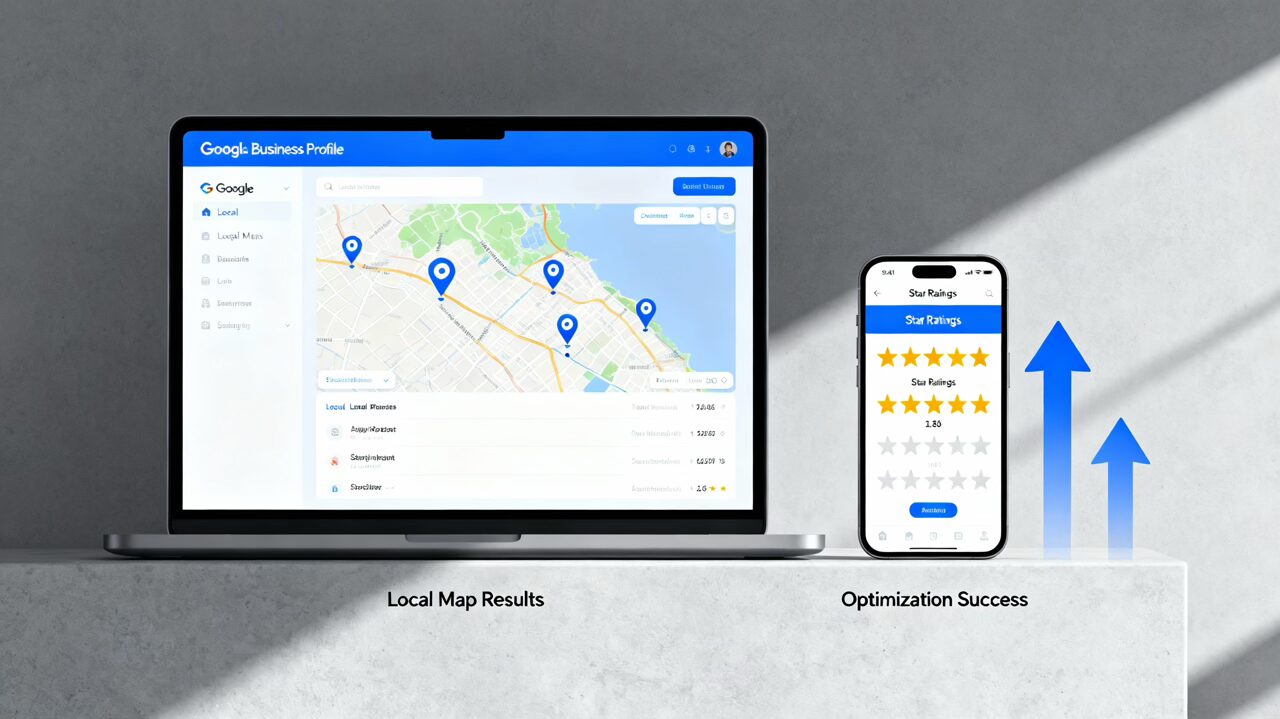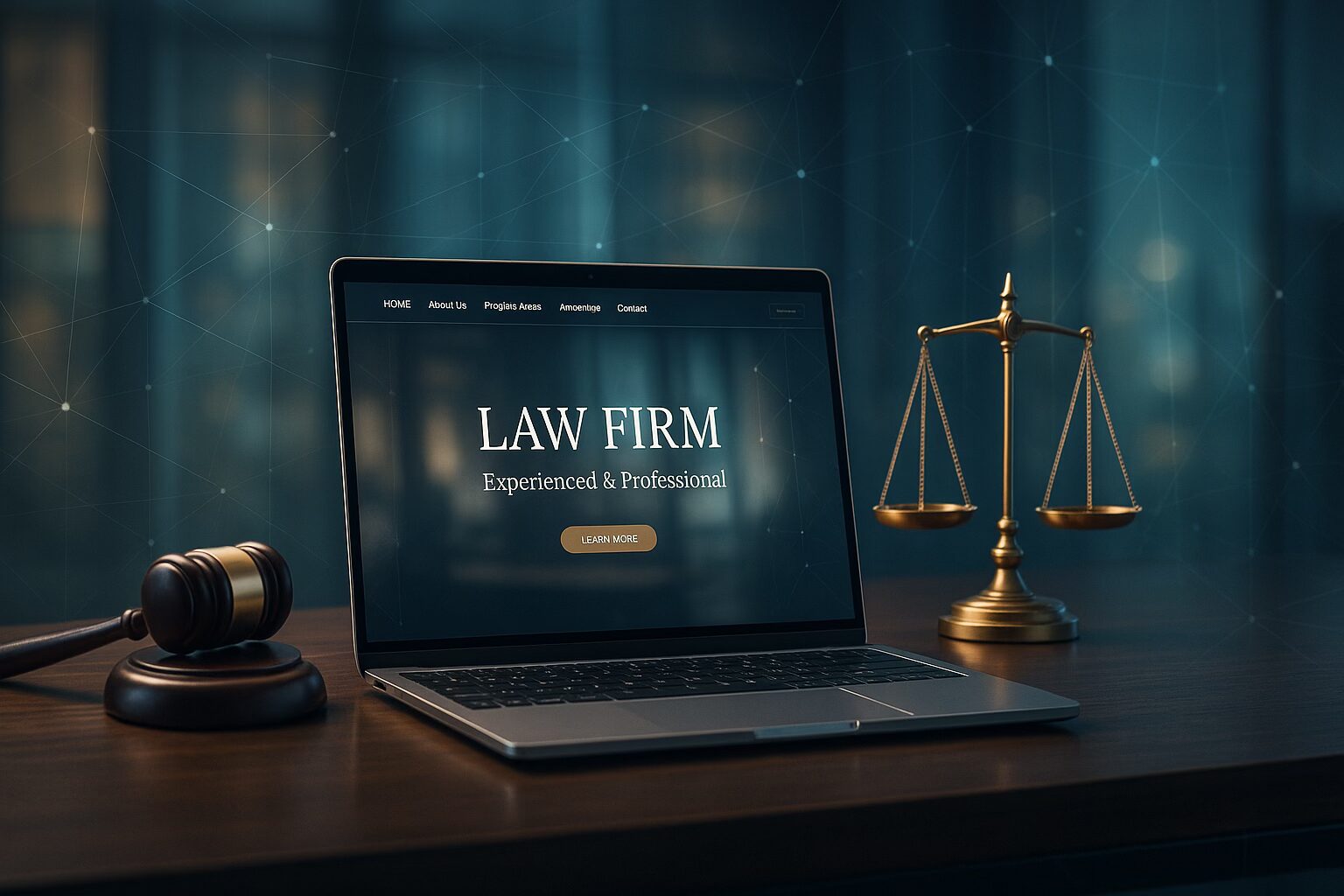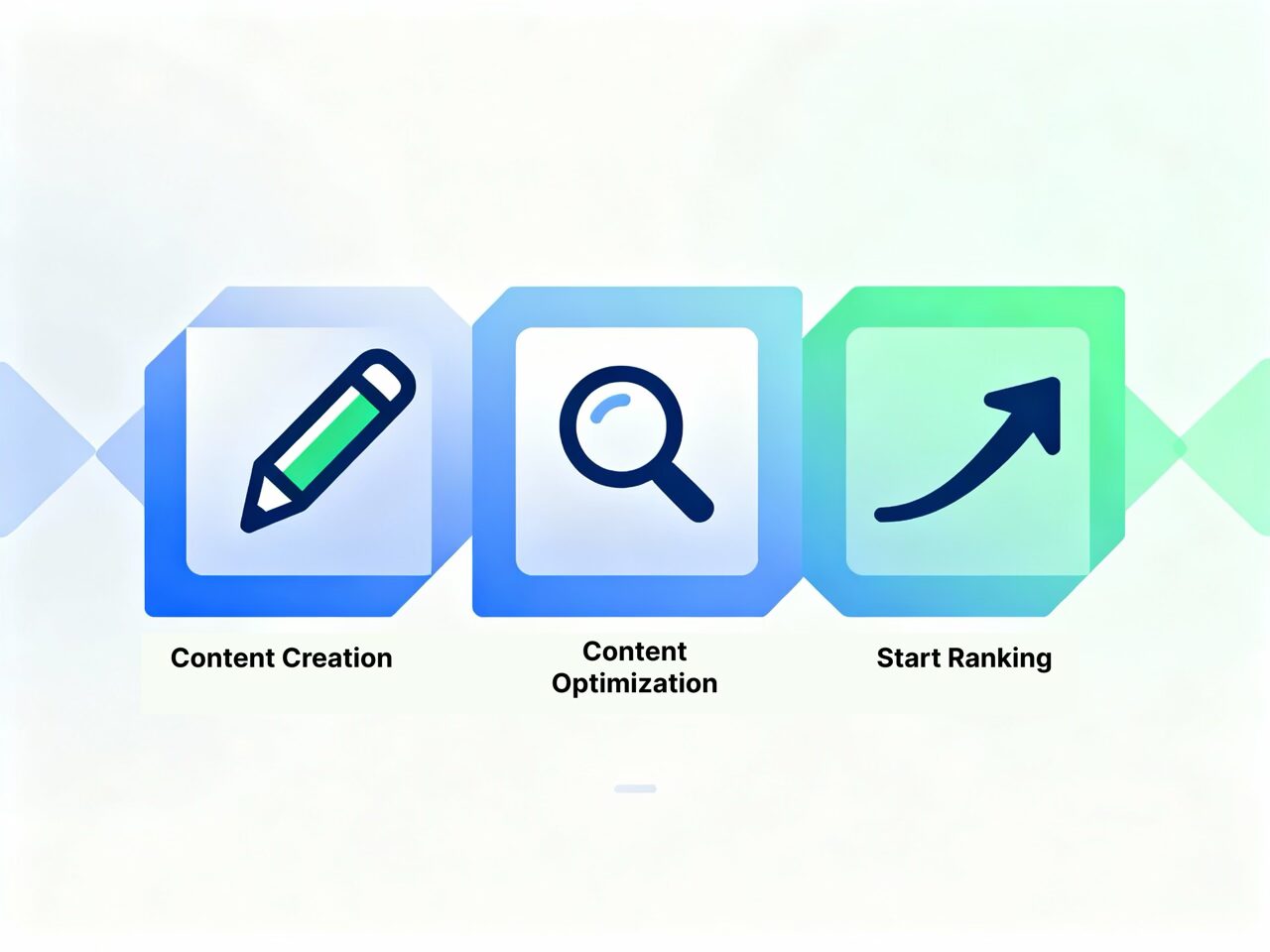If you’re serious about showing up when local customers search for your services, your Google Business Profile is your most powerful digital asset.
Nearly 98% of consumers now search online to find local businesses, and 76% of people who search for something nearby visit a business within 24 hours. That’s money sitting on the table if your profile isn’t optimized.
Here’s what most businesses miss: Google Business Profile optimization isn’t about filling out a form and forgetting it. It’s an ongoing competitive advantage that can deliver a 68X ROI when executed properly. Businesses that appear in Google’s Local 3-Pack receive 126% more traffic and 93% more customer actions than those that don’t. And unlike traditional SEO that takes 3-6 months to show results, GBP optimization can start driving measurable improvements within the first 30-90 days.
This guide breaks down exactly how to optimize your Google Business Profile using proven strategies, real data, and tactics that actually work in 2025. Whether you’re starting from scratch or looking to outrank competitors, you’ll learn the complete framework for turning your GBP into a lead-generating machine.
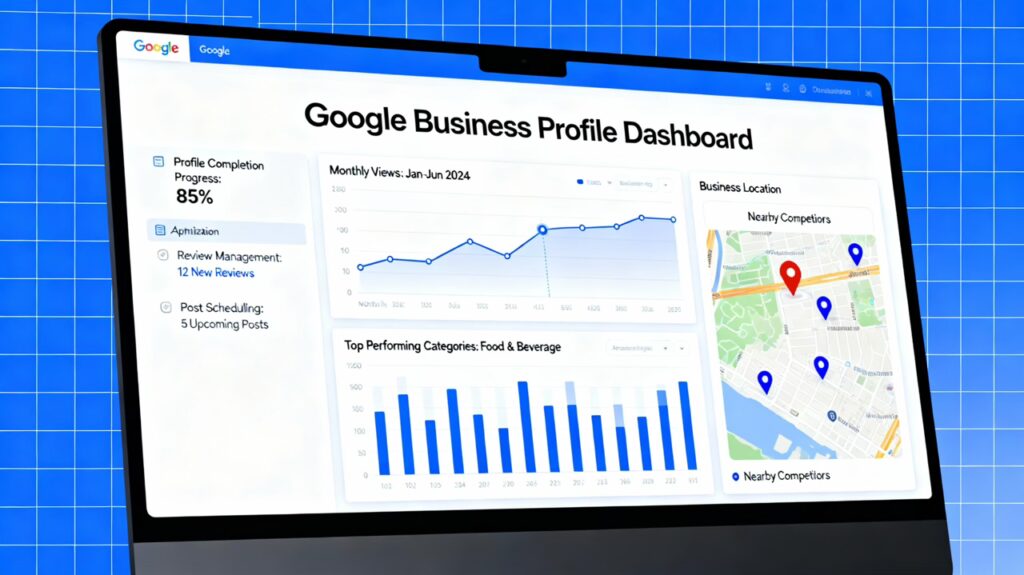
What Is Google Business Profile Optimization (And Why It Matters More Than Ever)
Google Business Profile optimization is the strategic process of enhancing your business listing to improve visibility in local search results, Google Maps, and the coveted Local 3-Pack. Unlike traditional website SEO, GBP optimization targets location-based searches like “plumber near me” or “best Italian restaurant in Tampa”. These are queries that represent immediate buyer intent.
The business impact is measurable. An optimized Google Business Profile receives between 80 to 300 clicks per month, with the average profile generating 143 total interactions, 48 calls, and 59 website clicks monthly. When you consider that 28% of local searches result in a purchase and 90% of searchers buy within a week, the revenue potential becomes clear.
Google ranks local businesses using three primary factors: Relevance (how well your profile matches the search query), Distance (proximity to the searcher), and Prominence (how well-known and trusted your business is). While you can’t change your physical location, you can dramatically improve relevance and prominence through strategic optimization.
The Three Pillars of Google Business Profile Ranking
Understanding how Google evaluates and ranks local businesses is essential before diving into tactics. Recent studies analyzing over 2 million Google Business Profiles revealed specific patterns in what makes profiles rank higher.
1. Proximity: The Geographic Foundation
Distance to the searcher or search centroid accounts for 31-55% of ranking power depending on the industry and position. In highly competitive sectors like law, proximity dominates with 67-69% influence. While you can’t move your business, you can optimize your service area listings and ensure your address is verified and consistent across all platforms.
2. Reviews: The Trust Multiplier
Review volume and quality represent 19-27% of ranking factors for top positions. Businesses need a minimum 4.0-star rating to appear in searches containing “best” or “top”. More importantly, reviews with keyword relevance (customers mentioning specific services in their feedback) provide up to 26% additional ranking power.
The data is definitive: businesses with 200+ reviews generate twice the revenue of competitors with fewer reviews. And recency matters—73% of consumers ignore reviews older than one month.
3. Relevance: The Content Connection
Your Google Business Profile content which includes your business description, categories, services, posts, and Q&A responses determines how well Google matches your listing to search queries. Studies show top-ranking profiles have approximately 70 words in their business descriptions, while lower-ranking competitors use significantly shorter descriptions.
Profile completeness also matters. Google itself states that businesses with complete profiles are 2.7x more likely to be considered reputable and customers are 70% more likely to visit and 50% more likely to purchase.
Step-by-Step Google Business Profile Optimization Strategy
1. Claim, Verify, and Establish Your Foundation
Start by searching for your business name on Google. If a listing exists, claim it. If not, create one at business.google.com. Google requires verification—typically through a postcard with a code sent to your business address, though phone and email verification are sometimes available.
Critical foundation elements:
- Business Name: Use your exact legal name. Avoid keyword stuffing (e.g., “Joe’s Plumbing | 24/7 Emergency Plumber Tampa”) as this violates Google’s guidelines and can result in suspension. Google’s AI now detects keyword-stuffed names, leading to penalties.
- Primary Category: This is your single most important ranking factor. Choose the most specific category that accurately describes your core business. Don’t select “Restaurant” when “Italian Restaurant” or “Pizza Restaurant” is more precise.
- Secondary Categories: Add up to 9 additional categories to cover ancillary services, but prioritize accuracy over volume.
- Business Description: Write a compelling 500-character description that naturally incorporates relevant keywords while explaining what makes your business unique. Focus on services, location, and differentiators rather than promotional language.
2. Perfect Your NAP Consistency
NAP (Name, Address, Phone number) consistency is non-negotiable for local SEO success. Google cross-references your GBP information against thousands of online directories, citation sources, and your website. Inconsistencies signal unreliability, which damages rankings.
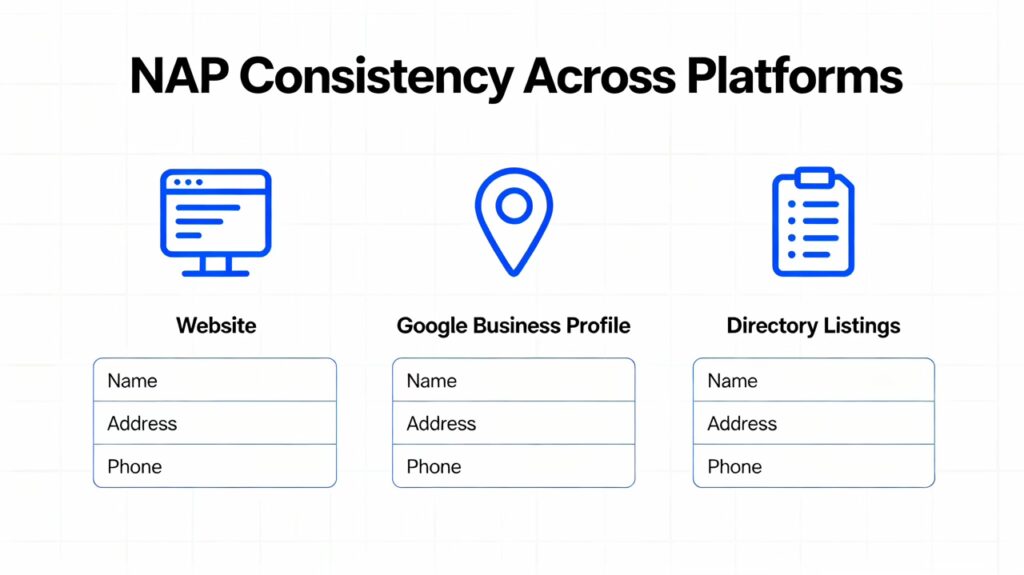
NAP optimization checklist:
- Ensure your business name, address, and phone number are identical across your GBP, website, social media, and directory listings
- Avoid abbreviations unless standardized (use “Suite 5” consistently, not “Ste. 5” on one platform and “#5” on another)
- Create a master NAP document to maintain consistency across all future listings
- Audit existing citations using tools like Moz Local, BrightLocal, or Whitespark
- Update or remove duplicate listings that contain conflicting information
3. Master the Review Generation System
Reviews are your social proof, trust signal, and ranking amplifier all in one. Here’s how to build a sustainable review strategy:
Generate consistent reviews:
- Ask satisfied customers immediately after positive interactions—at checkout, after service completion, or via follow-up email
- Send direct review links via text or email (create a shortened URL to your GBP review page)
- Display QR codes in-store that link directly to your review page
- Train staff to make review requests part of the customer experience
Respond to every review:
- Reply to positive reviews with genuine thanks and personal details
- Address negative reviews professionally, acknowledge concerns, and offer solutions
- Response rate correlates with higher engagement—businesses that respond to 32% of reviews see 80% higher conversion rates
- Never ask customers to change or delete negative reviews—this violates Google’s policies
Leverage review photos:
Photos attached to reviews increase how long that review stays in the “top reviews” section, potentially pushing negative reviews down and keeping positive reviews visible longer.
4. Optimize Visual Content for Engagement
Businesses with photos receive 42% more requests for directions and 35% more website clicks compared to profiles without visuals. Visual content serves multiple functions: engagement proxy (signaling activity), contextual clues (helping Google understand your business), and conversion driver (persuading customers to visit).
Photo strategy:
- Exterior photos: Help customers recognize your building from the street
- Interior photos: Showcase your environment, ambiance, and cleanliness
- Product/service photos: Display your offerings with quality, well-lit images
- Team photos: Humanize your business and build trust
- Before/after photos: Demonstrate results for service businesses
Upload at least one new photo monthly, and ideally refresh visuals every couple of weeks for businesses in competitive markets. Avoid stock photos—Google and customers both favor authentic imagery that represents your actual business.
Video content:
Short video tours, unboxing clips, or service demonstrations increase engagement and provide Google with richer context about your business. Videos don’t need to be professionally produced, but they should be clear, well-lit, and relevant.
5. Publish Strategic Google Posts
Google Posts appear directly on your GBP listing and expire after 7 days. For most businesses, posting once per week is the minimum, while 2-3 times per week yields better rankings and engagement.
Post types and use cases:
- Offers: Limited-time promotions, discount codes, seasonal sales
- Events: In-store happenings, workshops, community participation
- What’s New: New product arrivals, service announcements, business updates
- Seasonal content: Holiday hours, weather-related tips, seasonal reminders
Posting best practices:
- Include a clear call-to-action button (Learn More, Book Now, Call Now)
- Add relevant keywords naturally within post content
- Use high-quality images with each post
- Maintain consistency over bursts—weekly posts outperform sporadic activity
- Batch-create content to maintain sustainable schedules
6. Leverage Attributes and Advanced Features
Attributes are specific tags that highlight features or characteristics of your business. They help you appear in filtered searches (e.g., “wheelchair accessible restaurants near me”) and provide customers with important details.
Common attribute categories:
- Accessibility: Wheelchair accessible entrance, parking, seating
- Amenities: Free Wi-Fi, outdoor seating, restrooms
- Payment options: Credit cards, mobile payments, contactless
- Service options: Delivery, takeout, dine-in, online appointments
- Identity attributes: Women-owned, LGBTQ+ friendly, veteran-owned
Select all relevant attributes in your GBP dashboard—Google periodically adds new options, so audit this section quarterly.
7. Activate Q&A and Messaging Features
The Questions & Answers section allows anyone to ask questions about your business, and anyone can answer. This creates risk if left unmanaged but opportunity when used proactively.
Q&A optimization:
- Don’t wait for questions—seed your Q&A section with 5-7 common questions and authoritative answers
- Address topics like parking, payment methods, appointment requirements, service areas, and hours
- Monitor new questions and respond promptly (within 24 hours)
- Use natural, conversational language that mirrors how customers speak
Messaging:
Enable messaging in your GBP dashboard to allow direct customer contact. Respond to messages within 24 hours—59% of consumers expect responses within this timeframe.
8. Add Products and Services
For retail businesses, the Products feature lets you showcase items directly on your GBP. Restaurants can add menu items to help rank for dish-specific searches like “Pad Thai near me”. Service businesses should detail all offerings with clear descriptions and pricing where appropriate.
This feature increases visibility for item-specific searches and provides customers with clarity before they contact you.
Common Google Business Profile Mistakes That Kill Rankings
Even experienced marketers make critical errors that sabotage their local visibility. Avoid these pitfalls:
Keyword Stuffing in Business Name
Adding keywords like “Best Emergency Plumber | 24/7 Service” to your business name is a fast track to suspension. Google’s AI actively detects this manipulation, and penalties can be permanent.
Incomplete Profile Information
Missing business hours, incomplete service descriptions, or unfilled attribute fields signal low quality to Google. Customers are 2.7x more likely to consider businesses with complete profiles as reputable.
Ignoring Negative Reviews
Failing to respond to negative feedback damages your reputation and conversion rates. Businesses that respond professionally to criticism demonstrate accountability and customer focus.
Inconsistent NAP Data
Even minor variations—”Street” vs. “St.” or different phone number formats—create confusion for Google’s verification systems and hurt rankings.
Using Spammy Tactics
Creating duplicate listings, using virtual offices without actual operations, or soliciting fake reviews all violate Google’s guidelines and can result in permanent removal.
Outdated Information
Failing to update holiday hours, seasonal changes, or closed days frustrates customers and creates negative reviews. Keep your profile current.
Static Content
Profiles that haven’t been updated in months look abandoned to both Google and customers. Regular posts, fresh photos, and new reviews signal active management.
How Professional Web Design Amplifies GBP Results
Your Google Business Profile and website work together as a unified local search presence. When someone clicks through from your GBP to your website, what they find there determines whether they convert into a customer or bounce back to your competitors.
The Website-GBP Connection
Google evaluates the authority and relevance of your linked website as part of its GBP ranking algorithm. The domain authority of your website contributes 5-12% of ranking power depending on industry. A well-optimized, professionally designed website reinforces the trust signals your GBP establishes.

Conversion-focused design elements:
- Mobile responsiveness: 96% of global internet users access websites via mobile. Your site must provide seamless experiences across all devices
- Clear navigation: Simplified menus and intuitive architecture help visitors find information quickly
- Prominent CTAs: Call buttons, booking forms, and contact options should be immediately visible
- Local trust signals: Display your NAP information prominently, embed your Google Map, and showcase customer reviews
- Fast loading speed: Site speed impacts both user experience and SEO rankings
Why Professional Design Matters for Local Businesses
A professionally designed website signals credibility and competence. When customers click through from your GBP and encounter a modern, well-structured site, it validates their decision to engage with your business.
Key benefits of professional web design:
- Builds trust immediately: 94% of first impressions relate to design
- Improves conversion rates: Professional design guides visitors toward desired actions
- Strengthens SEO: Proper site structure, schema markup, and technical optimization improve organic rankings
- Reduces bounce rate: Intuitive design keeps visitors engaged longer
- Creates brand consistency: Your website should mirror the professionalism of your GBP
What Makes a High-Converting Local Business Website
The most effective local business websites share specific characteristics:
Strategic content structure:
- Homepage clearly states what you do, where you serve, and why you’re different
- Service pages target specific local keywords and buyer intent
- Location pages for multi-location businesses with unique content for each
- About page that builds rapport and showcases expertise
Local SEO integration:
- Embedded Google Map showing your location
- Schema markup for local business information
- NAP information in footer and contact page
- Location-specific blog content
Conversion optimization:
- Click-to-call buttons prominently displayed on mobile
- Online booking or quote request forms
- Social proof elements (reviews, testimonials, case studies)
- Clear value propositions above the fold
How Devbo Builds Google Business Profile-Optimized Websites
At Devbo, we understand that your Google Business Profile and website aren’t separate marketing channels—they’re interconnected assets that must work in harmony to dominate local search and convert visitors into customers.
Our approach combines technical SEO excellence, conversion-focused design, and local search strategy:
GBP-Website Integration:
We ensure perfect NAP consistency between your GBP and website, implement proper schema markup to help Google understand your business, and create location-specific landing pages that reinforce your local relevance. When Google analyzes your website as part of your GBP ranking evaluation, it finds strong authority signals that boost your visibility.
Mobile-First Design:
With the majority of local searches happening on mobile devices, we build responsive websites that provide exceptional experiences on smartphones and tablets. Fast load times, intuitive navigation, and prominent call-to-action buttons ensure that mobile visitors can quickly find information and take action.
Conversion Architecture:
Beautiful design means nothing without conversions. We structure every page to guide visitors toward contact forms, phone calls, or booking systems. Strategic placement of trust elements—customer reviews, certifications, and project galleries—builds confidence at every stage of the buyer journey.
Ongoing Optimization:
Local search doesn’t stand still, and neither do we. We monitor performance metrics, conduct competitor analysis, and continuously refine both your GBP and website to maintain competitive advantages. Regular content updates, technical audits, and strategic enhancements ensure sustained results.
Timeline: When to Expect Results from GBP Optimization
Understanding realistic timelines helps set proper expectations and maintain momentum through the optimization process.
Week 1-2: Foundation Phase
- Claim and verify your Google Business Profile
- Complete all basic information fields
- Upload initial photos and select categories
- Establish NAP consistency across major platforms
Expected results: Profile visibility begins, though ranking improvements are minimal.
Month 1-3: Growth Phase
- Accumulate 15-30 reviews through systematic outreach
- Publish weekly Google Posts consistently
- Upload fresh photos every 2-4 weeks
- Optimize Q&A section with relevant questions
Expected results: Businesses in low-competition markets may begin appearing in the Local 3-Pack. Engagement metrics (clicks, calls, direction requests) show measurable improvement.
Month 3-6: Maturity Phase
- Continue review generation to reach 50+ total reviews
- Maintain posting consistency and engagement
- Refine content based on performance data
- Build additional local citations and backlinks
Expected results: Significant ranking improvements for competitive keywords. Businesses typically achieve stable Local 3-Pack positions for primary search terms by month 4-6.
Important note: Results vary based on competition level, industry, and consistency of optimization efforts. Businesses in highly competitive markets (legal, healthcare, real estate) may require 6+ months for top rankings.
Measuring Success: Key Performance Indicators
Google Business Profile Insights provides valuable data to track optimization effectiveness. Monitor these metrics monthly:
Discovery Metrics:
- Direct searches: Customers searching your business name specifically
- Discovery searches: Customers finding you through category/service searches
- Branded vs. non-branded ratio: Healthy profiles show growth in discovery searches
Engagement Metrics:
- Profile views: Total times your profile appears to users
- Search queries: Actual terms customers used to find you
- Website clicks: Visitors clicking through to your site
- Call button clicks: Phone engagement from mobile users
- Direction requests: Customers navigating to your location
Conversion Indicators:
- Messaging conversations initiated
- Booking completions (if enabled)
- Review volume growth rate
- Average review rating trend
Set up UTM tracking on your GBP website link to measure conversions in Google Analytics and attribute revenue to your GBP optimization efforts.
Frequently Asked Questions About Google Business Profile Optimization
How long does it take to rank #1 in Google’s Local 3-Pack?
For most businesses, it takes 4-6 months to achieve stable rankings for competitive local keywords. However, meaningful improvements can occur within the first 30-90 days, especially in less competitive markets. Consistency with optimization efforts—reviews, posts, photos, and engagement—is more important than any single tactic.
How often should I post updates on my Google Business Profile?
Post at least once per week as a minimum standard. Businesses posting 2-3 times weekly see better engagement and rankings. Consistency matters more than volume—weekly posts year-round outperform irregular bursts of activity.
Do I need 5-star reviews to rank well?
Not necessarily. You need a minimum 4.0-star average to appear in searches containing “best” or “top”. More importantly, review volume and recency matter significantly—100 reviews at 4.3 stars typically outrank 20 reviews at 4.9 stars. Focus on generating consistent new reviews rather than obsessing over perfect ratings.
What’s the ideal number of photos to upload?
Start with at least 10-15 high-quality photos covering your exterior, interior, products/services, and team. Add new photos monthly at minimum, or every 2-4 weeks for competitive industries. Businesses with more photos generate significantly more engagement.
Can I optimize my GBP if I’m a service-area business without a storefront?
Yes. Service-area businesses (SABs) can optimize GBP profiles by specifying service areas instead of displaying a physical address. Focus on detailed service descriptions, robust reviews, and content that reinforces your service locations.
Should I respond to every review?
Yes, especially for businesses with fewer than 100 reviews. Responding to reviews—both positive and negative—signals active management and customer care. Businesses that respond to at least 32% of reviews see 80% higher conversion rates.
How do I handle duplicate Google Business Profiles?
Report duplicates through your GBP dashboard or the Google Business Profile Help Forum. Never create new listings to “replace” duplicates—this can lead to suspension. Work with Google support to merge or remove unauthorized duplicates.
Does my website need to be fancy for GBP optimization to work?
Your website doesn’t need expensive design, but it must be mobile-friendly, fast-loading, and contain accurate NAP information matching your GBP. A professional website strengthens your GBP rankings by providing authority signals to Google.
What’s the difference between Google Business Profile and Google My Business?
They’re the same product—Google rebranded “Google My Business” to “Google Business Profile” in 2021. The functionality remains the same; only the name changed.
Can I rank in the Local 3-Pack if my business is outside the city center?
Yes, but proximity is a significant ranking factor (31-69% depending on industry). Optimize every other controllable factor—reviews, relevance, profile completeness—to compensate for distance. Service-area businesses can specify multiple service locations to improve coverage.
Taking Action: Your Next Steps
Google Business Profile optimization isn’t a one-time project—it’s an ongoing competitive advantage that compounds over time. The businesses dominating local search in 2025 didn’t get there by accident. They implemented systematic optimization, maintained consistency, and aligned their digital presence around local search best practices.
Start with your foundation: claim or verify your GBP, ensure NAP consistency, and complete every available field. Build momentum through reviews, weekly posts, and fresh visual content. Connect your GBP to a professionally designed, conversion-optimized website that reinforces your local authority.
The data is clear: businesses that optimize their Google Business Profile generate 126% more traffic and 93% more customer actions than competitors who don’t. With 98% of consumers searching online for local businesses and 76% visiting within 24 hours, your optimized GBP becomes your most valuable digital asset.
Ready to dominate local search in your market?
Devbo specializes in comprehensive Google Business Profile optimization paired with high-converting web design for businesses in Clearwater, FL and beyond. We handle the technical complexity while you focus on serving customers. Contact Us today to schedule your local search audit and discover how we can transform your digital presence into a consistent lead-generation engine.



